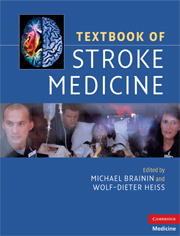Book contents
- Frontmatter
- Contents
- Preface
- List of contributors
- Section I Etiology, pathophysiology and imaging
- Section II Clinical epidemiology and risk factors
- Section III Diagnostics and syndromes
- 8 Common stroke syndromes
- 9 Less common stroke syndromes
- 10 Intracerebral hemorrhage
- 11 Cerebral venous thrombosis
- 12 Behavioral neurology of stroke
- 13 Stroke and dementia
- 14 Ischemic stroke in the young and in children
- Section IV Therapeutic strategies and neurorehabilitation
- Index
- References
11 - Cerebral venous thrombosis
from Section III - Diagnostics and syndromes
Published online by Cambridge University Press: 05 May 2010
- Frontmatter
- Contents
- Preface
- List of contributors
- Section I Etiology, pathophysiology and imaging
- Section II Clinical epidemiology and risk factors
- Section III Diagnostics and syndromes
- 8 Common stroke syndromes
- 9 Less common stroke syndromes
- 10 Intracerebral hemorrhage
- 11 Cerebral venous thrombosis
- 12 Behavioral neurology of stroke
- 13 Stroke and dementia
- 14 Ischemic stroke in the young and in children
- Section IV Therapeutic strategies and neurorehabilitation
- Index
- References
Summary
Introduction
Acute thrombosis of the cerebral sinuses and veins (cerebral venous thrombosis, CVT) is considered to be the cause of an acute stroke in approximately 1% of all stroke patients. However, the incidence of CVT is not known, as population-based studies are lacking. It has been estimated that annually about five to eight cases of CVT are identified among stroke patients of tertiary care hospitals [1]. Historically, CVT was considered a severe, almost inevitably fatal disease, as diagnosis in the pre-angiograph era was usually made post-mortem. However, modern neuroimaging techniques allow the diagnosis of CVT at an early stage and document that CVT is more frequent than was traditionally assumed, and that its prognosis is much better than is generally accepted, provided that the diagnosis is suspected, the respective neuroimaging examinations are performed in a timely manner, and therapy is initiated early, i.e. often with the diagnosis being clinically suspected only. The variety of clinical signs and symptoms renders the diagnosis of CVT a challenge to the physician. Diagnosis is still frequently overlooked or delayed due to the wide spectrum of clinical symptoms and the often subacute or lingering disease onset.
It is important to keep the diagnosis of CVT in mind in stroke cases that present with a fluctuating course, headache, epileptic seizures or disturbances of the level of consciousness. With timely therapeutic intervention, CVT has a favorable prognosis, with an overall mortality rate of about 8% in recent studies [2].
- Type
- Chapter
- Information
- Textbook of Stroke Medicine , pp. 165 - 177Publisher: Cambridge University PressPrint publication year: 2009

